2019 Activity Report for Mission 5-2: Establishing a Society with Reduced Dependence on Fossil Resources: Plants, Biomass, Energy, and Materials
Updated: 2020/05/20
Award
New Chemical Technology Research Encouragement Award
【Winner】 Hiroshi Nishimura(Assistant Professor, Laboratory of Biomass Conversion, RISH)
【Awarding Organization】 The Japan Association for Chemical Innovation (JACI)
【Date】 June 2019
【contribution】 Research on innovative materials and technologies of biomass-derived products for the sustainable society. Title “New development of natural lignocellulosic polymers based on molecular properties”
2nd Best Poster Award
【winner】Subyakto(Professor, LIPI), R. Marlina(LIPI), N. Masruchin(LIPI), T. Hata(RISH), Y. Onishi(Lygnite Co.Ltd), I. Ide(Lygnite Co.Ltd)
【Awarding Organization】The 3rd International Symposium of JSPS Alumni Association of Indonesia
【Date】October 2019
【contribution】Preparation of a New Electrode for Capacitor from Char of Oil Palm Empty Fruit Bunches
Research 1: Tailor-made breeding of grass biomass through lignin bioengineering
RISH investigator(s): Toshiaki Umezawa, Yuki Tobimatsu, Shiro Suzuki
Outside collaborator(s): Tokushima University, Nara Institute of Science and Technology (NAIST), Earthnote Co., The University of Hong Kong, University of Wisconsin, Oklahoma University, US DOE Bioenergy Research Center, CAS Shanghai Institute of Plant Physiology and Ecology, etc
To explore new breeding strategies to improve the production of bioenergy and biomaterials from grass biomass, this project seeks to develop and characterize transgenic rice plants that produce biomass with variously modified lignin contents and structures. To this end, new lignin-modified transgenic rice lines are being developed via up- and/or down-regulations of lignin biosynthesis pathway genes. We are also working on the selection and breeding of grass biomass crop varieties that show superior lignin characteristics.
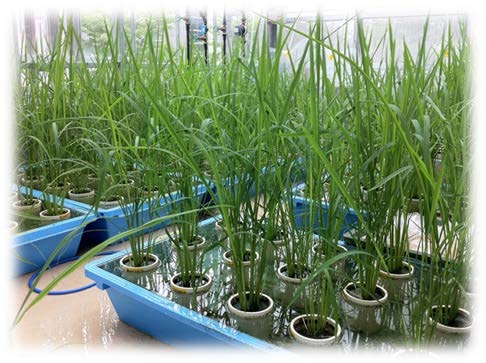 |
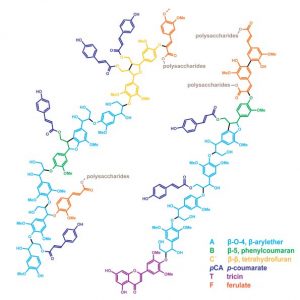 |
Figure: Lignin-modified transgenic rice plants grown in a greenhouse (left) and structural models of lignins in grass biomass or cell walls (right).
Publications, etc.
- Lam et al., OsCAldOMT1 is a bifunctional O-methyltransferase involved in the biosynthesis of tricin-lignins in rice cell walls. Scientific Reports, 9:11597 (2019).
- Lam et al., Recruitment of specific flavonoid B-ring hydroxylases for two independent biosynthesis pathways of flavone-derived metabolites in grasses. New Phytologist, 223: 2014-219 (2019).
- Martin et al., Altered lignocellulose chemical structure and molecular assembly in CINNAMYL ALCOHOL DEHYDROGENASE-deficient rice. Scientific Reports, 9: 17153 (2019).
- Wahyuni et al., Variation in lignocellulose characteristics of 30 Indonesian Sorghum (Sorghum bicolor) accessions. Industrial Crops and Products, 142: 111840 (2019).
- Gui et al., Phosphorylation of LTF1, a MYB transcription factor in Populus, Acts as a sensory switch regulating lignin biosynthesis in wood cells. Molecular Plant, 12:1325-1337 (2019).
- Lee et al., Lignin‐based barrier restricts pathogens to the infection site and confers resistance in plants. The EMBO Journal, e101948 (2019).
- Tobimatsu et al. Solution-state multidimensional NMR of lignins: approaches and applications. In: Lu F. and Yue F. (eds) Lignin: Biosynthesis, Functions, and Economic Significance, pp 79-110, Nova Science Publishers Inc. (2019).
- Miyamoto et al., Double knockout of OsWRKY36 and OsWRKY102 boosts lignification with altering culm morphology of rice. Plant Science 296: 110466 (2020).
- Gui et al., Fiber‐specific regulation of lignin biosynthesis improves biomass quality in Populus. New Phytologist, 226: 1074-1087 (2020).
- Lui et al., Convergent recruitment of 5´‐hydroxylase activities by CYP75B flavonoid B‐ring hydroxylases for tricin biosynthesis in Medicago legumes. New Phytologist, in press (DOI: 10.1111/nph.16498).
Research 2: Metabolite production platform using lipid-secreting plant cells
RISH investigator(s): Kazufumi Yazaki, Akifumi Sugiyama
Outside collaborator(s): RIKEN
Plants have developed lipid secretion mechanisms to protect themselves from dryness since the land colonization in ancient ages. This lipid secretion ability is especially prominent in epidermal cells, where wax and cutins as well as suberin are secreted. In term, some other characteristic cell types related to oil glands and glandular trichomes are also involved in secretion of lipid-soluble low molecular weight substances, like secondary metabolites. One of such examples is Lithospermum erhthrorhizon, in which root epidermal cells are secreting a large amount of secondary metabolic lipids, i.e., shikonin derivatives. The cultured cells of this plant show shikonin productivity of ca. 10% of cell dry weight. In this study, we are trying to develop a platform to produce high value lipid-soluble metabolites utilizing the lipid secreting ability of this plant cells.
Publications, etc.
-
- Tatsumi et al., Highly efficient method of Lithospermum erythrorhizon transformation using domestic Rhizobium rhizogenes strain A13, Plant Biotech., in press.
- Shitan and Yazaki, Dynamism of vacuoles toward survival strategy in plants, Biophys. Acta – Biomembranes, in press.
- Kusano et al., Evolutionary developments in plant specialized metabolism, exemplified by two transferase families, Front. Plant Sci., 10:794 (2019).
Research 3: Conversion of biomass into chemical resources using a microwave and biological process
RISH investigator(s): Takashi Watanabe, Hiroshi Nishimura
Outside collaborator(s): Nippon Steel Engineering Co., Daicel Corporation, Taiyo Nippon Sanso Co., Kyoto University ICR, Kyoto University IAE, Tottori University, Thailand National Science and Technology Development Agency (NSTDA), Chulalongkorn University, Indonesian Institute of Science (LIPI), etc.
We are studying conversion system of tropical and domestic biomass into functional chemicals and biofuels. In FY 2019, we started an e-Asia program “Integrated Biorefinery of Sugarcane Trash”. The program is leaded by RISH, together with Graduate School of Energy Science of Kyoto University (KU), Institute of Advanced Energy of KU, National Science and Technology Development Agency (NSTDA), Chiang Mai University in Thailand, Indonesian Institute of Sciences (LIPI) and National University of Laos. This three-year project aims to convert sugarcane trash to advanced biofuels, useful chemicals and materials such as iso-butanol, lactic acid, xylitol and lignin-derived surfactant, thereby contributing to the sustainable development of local societies. In FY2019, we also studied wood solubilization in organic acid together with a private company.
Publications, etc.
- Qu, K. Ito, I. Katsuyama, T. Mitani, K. Kashimura, T. Watanabe, Microwave directly accelerated cleavage of C–C and C–O bonds of lignin by copper oxide–peroxide reaction, ChemSusChem, in press (2020).
- Watanabe, e-Asia project “Integrated Biorefinery of Sugarcane Trash”, The 1st Japan-ASEAN Multi-Stakeholder Strategic Consultancy Forum (Bangkok, Oct 12, 2020).
- Watanabe, Introduction of the e-Asia project “Integrated Biorefinery of Sugarcane Trash” Kick-Off Workshop of e-Asia project “Integrated Biorefinery of Sugarcane Trash” (Bangkok, Oct 13, 2020).
- Watanabe et al., Lignocellulosic Biorefinery Using Microwave Organosolvolysis. 7th Asian Conference on Biomass Science (ACBS 2019) (Kooriyama, Dec 10, 2019).
- Watanabe, Conversion of Lignocellulosic Biomass for Sustainable Humanosphere, Joint Symposium on Tropical Studies “Green Innovation on Tropical Forest and Forest Industries Toward Sustainable Livelihoods” (Berau, Sep 4-7, 2019).
Research 4: Design of green biomass conversion based on an analysis of branched structures on lignocellulose
RISH investigator(s): Hiroshi Nishimura, Takashi Watanabe
Outside collaborator(s): Chalmers University of Technology, Wallenberg Wood Science Center (WWSC), Kyoto University ICR, etc.
Advanced utilization of plant biomass needs a deeper understanding of the molecular structure of lignocellulose polymers. In particular, branched structures on lignocellulose, e.g., lignin-polysaccharide linkages, are critical to elucidate for converting biomass to useful chemicals, materials, and energy. Here, we established a highly concentrated fraction of lignin-carbohydrate complexes and purified by combining of carbohydrase enzymatic treatment and sequential chromatography. We succeeded in proving the covalent bond between lignin and hemicellulose by two-dimensional and three-dimensional NMR method. We are now trying to develop the environment-friendly green system of biomass conversion based on the accurate molecular structure analysis.
Publications, etc.
-
- Aoki et al., Evaluation of ring-5 structures of guaiacyl lignin in Ginkgo biloba L. using solid- and liquid-state 13C NMR difference spectroscopy, Holzforschung. 73:1083-1092 (2019).
- Nishimura, “Structural analysis of lignocellulosic biomass towards the efficient utilization”, e-ASIA kick-off symposium, Bangkok, Thailand, 2019.10.13 (Invited Talk).
Research 5: Development of high-strength products based on cellulose and chitin nanofibers
RISH investigators: Hiroyuki Yano, Kentaro Abe
Outside collaborator(s): Chuchu Chen (Nanjing Forestry University)
Recently, natural nanofibers such as those of cellulose and chitin, which are major components of plant cells and the shells of crabs and shrimp, respectively, have received great interest by virtue of their outstanding mechanical properties. The aim of this study is to develop high-strength products (film, spun fiber, filters, etc.) based on cellulose and chitin nanofibers. We have proposed a new method to fabricate the ionically cross-linked nanocomposite (ICN) hydrogels. The resultant hydrogels exhibit a readily adjustable elastic modulus and high fracture strength, which are comparable with those of skin and ligament. The high frictional force between the cellulose nanofibers and matrix is responsible for the stiffness of ICN hydrogels; while the tough matrix and weak direct interfibrillar interactions enable good stretchability. We expect that various kinds of cellulose nanofiber/polymer nanocomposite hydrogels with excellent mechanical properties and/or other features can be fabricated by simply changing the monomers.
Publications
- Tanpichai et al., A sustainable lignin-poor cellulose source for the production of cellulose nanofibers, ACS Sustain. Chem. Eng., 7:18884-18893 (2019).
- Yang et al., Stiffened nanocomposite hydrogels by using modified cellulose nanofibers via plug flow reactor method, ACS Sustain. Chem. Eng., 7:9092-9096 (2019).
- Yang et al., Fabrication of ultrastiff and strong hydrogels by in situ polymerization in layered cellulose nanofibers, Cellulose, 27: 693–702 (2020).
Research 6: Development of energy storage device from biomass
RISH investigator(s): Toshimitsu Hata
Research collaborator(s): Lignyte Inc., Indonesian Institute of Science (LIPI), Osaka Prefecture University, etc.
Development of energy storage device from biomass is promising due to the view of renewability, low cost, and sustainability. In this study, we prepared composite precursor from phenol resin and cellulose nanofiber (CNF). CNF and 50% KOH solution was added to phenol resin, and then carbonized/activated. Specific surface area and electrochemical property of carbonized carbon materials was evaluated with gas measurement and charge-discharge behavior, respectively. The discharge capacity of the capacitor from activated composite was higher than that of activated phenolic resin. The easiness of ion diffusion in the obtained 3D carbon structure may contribute to the discharge capacity.
Publications, etc.
- Hata and Subyakto. 2019. Experimental techniques for preparation and characterization of functional carbonized wood. LIPI Press, Jakarta (manuscript of Book Chapter).
- Subyakto, R. Marlina, N. Masruchin, T. Hata, Y. Onishi, I. Ide. 2019. Preparation of A New Electrode for Capacitor from Char of Oil Palm Empty Fruit Bunches. The 3rd International Symposium of JSPS Alumni Association of Indonesia. 31 October 2019, Bogor, Indonesia (Second best poster).
Research 7: Development of IoT technology with wireless power transfer via microwaves
RISH investigator(s): Naoki Shinohara, Tomohiko Mitani
Research collaborator(s): Panasonic Co., MinebeaAtsumi Inc., etc.
Toward a post-fossil-fuel society, IoT (Internet Of Things) technology for a sophisticated society is required. We are developing an unconscious wireless charging system and battery-less IoT sensor with wireless power transfer via microwaves. In this year, we develop high efficiency rectifying circuit for wearable rectenna (rectifying antenna). In circuit simulation, we reached 97.1% RF-DC conversion efficiency as world highest efficiency in 920MHz band, whose frequency and system is discussed to create new radio regulation in Information and Communications Council under Ministry of Internal Affairs and Communications in Japan. In parallel, we are developing microwave power aided sensor to investigate tunnel automatically from driving car. We will carry out field experiment with a car soon in special religion for scientific experiment (Tokku).
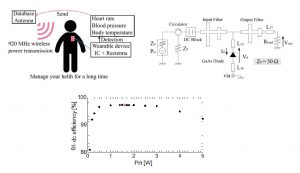
Fig. Image of Battery-Less Wearable Sensor, Simulation Model of 920MHz Rectifier, and Input Microwave Power Dependence of RF-DC Conversion Efficiency
Publications, etc.
- Kawai et al., Design of High Efficiency Rectifier Circuit for 920MHz Wireless Power Transmission, Proc. of IEEE WPW2020, accepted
Research 8: Estimation of microwave impacts on insect ecology from human activity
RISH investigator(s): Aya Yanagawa, Tomohiko Mitani
Research collaborator(s): INRA, Nara University of Education, Tezukayama Senior High School, Kyoto Institute of Technology.
The demand for microwave technology will continue to increase. Recently numbers of problems from the human activities show up such as the issues about microplastic contamination, honey bee colony collapsing, climate change etc. The possibility of serious impacts has been known but happened unexpectedly. Microwave is known to have an impact on living organism and its usage is carefully handled for human safety. While the influence on the other living organisms is not counted yet. For the safety and development of the IoT (Internet of Things), it is essential to learn its impacts on nature. We would like to establish a method for estimating such impact by using insect ecology as a model system.
Publications, etc.
- Yanagawa et al., Physical assessments of termites (Termitidae) under 2.45 GHz microwave irradiation, Sci. Rep., in press.
- Yanagawa, Energy transit petterns of 2.45GHz microwaves in termite body, Coptotermes formosanus, HSS2019/9th ISSH, Bogor, Indonesia (2019 Oct) (Invited Talk)


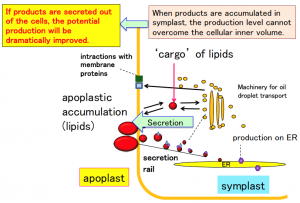
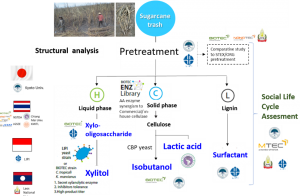

-300x154.png)

